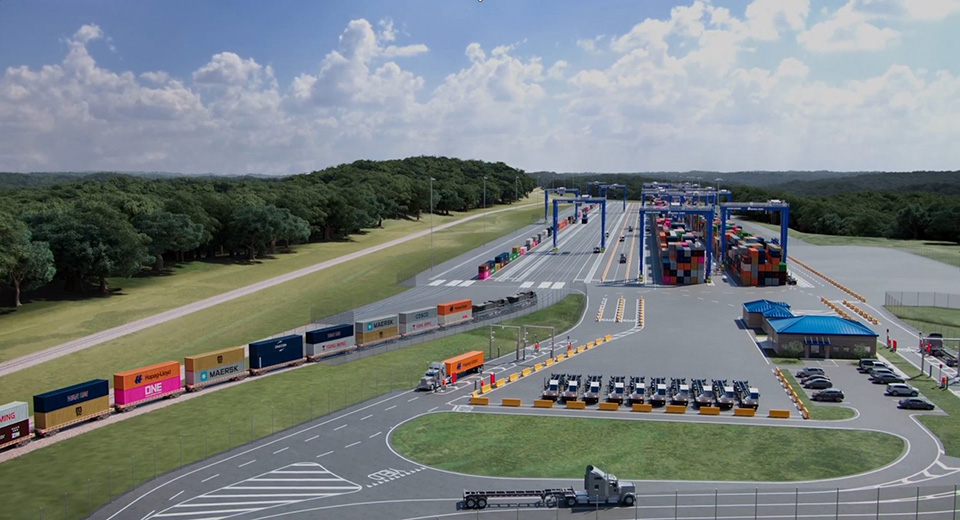
Georgia Ports continues its focus on infrastructure and engineering projects in 2024 to create business opportunities for customers, business partners, communities and rural Georgians.
The Blue Ridge Connector is a catalyst for enabling businesses to succeed through a competitive supply chain in a growing Northeast Georgia regional market. Opening in 2026, the Blue Ridge Connector will serve as an important connection for this growing distribution area.
Port officials offered an update recently to representatives from surrounding counties and customers about the arrival of this new infrastructure for future growth. Economic development officials from more than a dozen surrounding Georgia counties along with Lanier Technical College and Georgia Department of Economic Development leaders participated in a presentation to learn more about the impact of the Blue Ridge Connector on area commerce.
“The Blue Ridge Connector is designed to open access to world markets and create a positive economic impact in the Northeast Georgia region by connecting the Port of Savannah’s 37 weekly global services with Gainesville, Georgia,” said Stacy Watson, GPA’s Director of Economic & Industrial Development. “Every effort has been made to improve the supply chain experience, enable future growth while being sensitive to surrounding communities.”
The 104-acre location will link to the Port of Savannah’s Mason Mega Rail – the largest on-dock rail facility in North America, with daily rail departures on CSX and Norfolk Southern to inland markets. The port currently moves approximately 20% of cargo via rail to inland destinations and 80% by truck.
In addition to providing importers and exporters with efficient new options to move their cargo, the Blue Ridge Connector will also deliver sustainable logistics solutions via rail. By linking to the Port of Savannah via rail, the Blue Ridge Connector will reduce congestion on Georgia highways, eliminating the 600-mile roundtrip drive to and from the coast. This means offsetting emissions by as much as 75%, lowering transportation costs for importers and exporters and providing closer drayage for truck drivers who can transport containers in their own markets, closer to home.
The new inland port will be served by 14 hybrid-electric rubber-tire gantry cranes which reduce diesel dependency and use white noise audio features to curb noise. Equally important, efficient LED lighting will direct light downward within the facility, minimizing light pollution in nearby communities while reducing energy consumption.
“Our analysis of this market with customers and the market growth potential is lining up well. We’re excited about creating a new supply chain that makes our customers compete stronger, more sustainable and enable their long-term growth plans year-over-year,” added Taylor Worley of Georgia Ports Market Research and Economic Development who presented at the meeting.
Area officials have welcomed the historic investment by Georgia Ports, which will draw new investment to the state as the Northeast Georgia region continues to grow.
Georgia Ports

3 Comments
Leave a Reply
Cancel reply
Leave a Reply

Bulloch Public Safety
04/26/2024 Booking Report for Bulloch County

Georgia Lifestyle
DNR: Clean Feeders Save Birds

Crime & Safety
Body Found in Baldwin County Missing Person Investigation

Bulloch Public Safety
04/09/2024 Booking Report for Bulloch County

Bulloch Public Safety
04/01/2024 Booking Report for Bulloch County

Bulloch Public Safety
04/08/2024 Booking Report for Bulloch County

Bulloch Public Safety
04/22/2024 Booking Report for Bulloch County

Bulloch Public Safety
04/15/2024 Booking Report for Bulloch County






Tony Stephens
January 23, 2024 at 5:09 pm
We are tired of the noise pollution these rail cars are making and more frequent trips up and down railway with these wornout rail cars and equipment they use to repair them in Jacksonville now that place a ghost town they not repairing there equipment we are looking for a disastrous condition
Steve
January 24, 2024 at 9:52 am
What will the rail to truck ratios be once this rail is opened?
Sue
January 25, 2024 at 6:32 am
Is anyone addressing the issue of truck traffic on the roads getting to and from the ports to Gainesville? I am very concerned that the infrastructure cannot sustain this congestion.